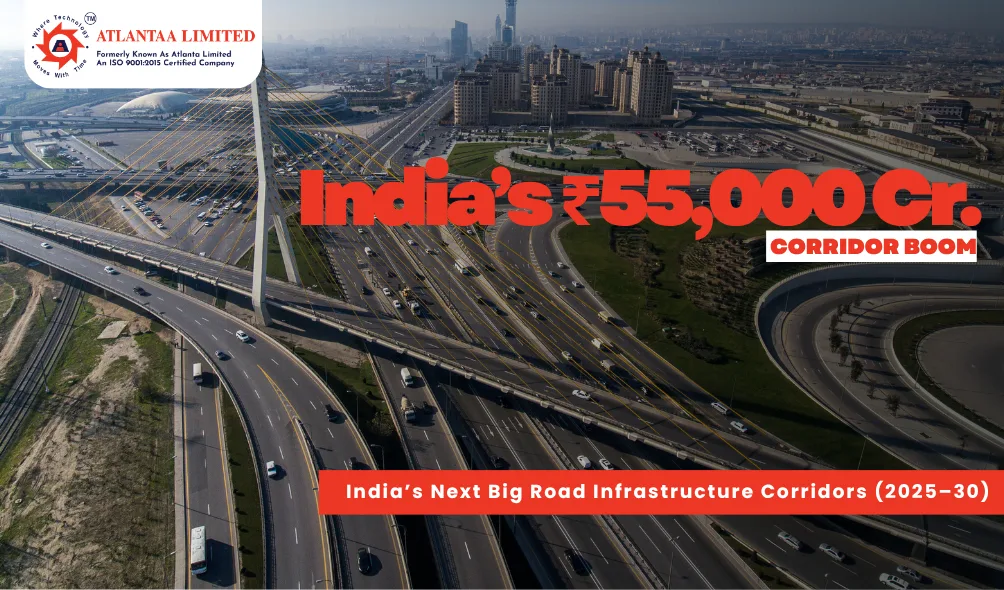EPC 15, Oct 2025
Future-Ready India: The Road Projects That Will Bring Every Major City Closer by 2030

India’s infrastructure sector stands at the threshold of a major leap. With the government targeting over 65,km of new highways by 2030, the focus has shifted toward high-speed expressways, economic corridors, and hybrid financing models that can sustain this scale. These projects will define how people and goods move across the country, while creating new growth centers and long-term investment corridors.
India’s Mega Corridor Vision (2025–30)
Under Bharatmala Phase II, the Ministry of Road Transport and Highways (MoRTH) and NHAI are expanding greenfield expressways and multimodal logistics links. Some of the most transformative corridors include:
- Delhi–Mumbai Expressway (1,386km) – Cutting travel time by 50%, powering industrial zones in Gujarat, Rajasthan, and Maharashtra.
- Mumbai–Nagpur Samruddhi Mahamarg (701km) – Integrating tier-and tier-cities into a new economic spine.
- Chennai–Bengaluru Industrial Corridor – Boosting India’s southern manufacturing competitiveness.
- Virar–Alibaug Multimodal Corridor (126km) – A gamechanger for MMR, linking economic nodes like Panvel, Bhiwandi, and Thane.
Such mega projects require engineering precision and financial discipline—domains where long-established EPC players like Atlantaa Limited bring decades of proven expertise.
The Economic Ripple Effect: How Corridors Shape Regional Growth
According to Knight Frank’s Infrastructure Impact Report, property values near major corridor alignments in Maharashtra have grown 15–25% post-project announcement. In the Mumbai Metropolitan Region (MMR), the MTHL and Samruddhi Mahamarg are already transforming growth patterns.
For example, the Virar–Alibaug Corridor alone is expected to cut travel time by over 50% and catalyze development across Kalyan, Panvel, and Taloja. With similar upcoming projects like the Madh–Versova Sea Link, local real estate values are projected to rise by up to 25% in surrounding micro-markets once operational.
These infrastructure corridors don’t just create mobility—they expand India’s economic geography, and EPC leaders like Atlantaa Limited play a critical role in executing these technically complex, high-impact corridors.
The Evolution of India’s Infra Financing: From BOT to HAM
India’s road sector financing has evolved significantly:
- The BOT (Build–Operate–Transfer) model once dominated, but faced funding and viability challenges.
- The EPC (Engineering–Procurement–Construction) model ensured faster execution by shifting risk to the government.
- The Hybrid Annuity Model (HAM) now combines both worlds—balancing execution speed and private investment sustainability.
Government policy has pivoted to prioritize EPC execution for speed, especially under tight delivery timelines. This shift has favored experienced developers like Atlantaa Limited, who possess deep technical expertise and a track record in BOT and EPC projects across India, including highways, bridges, and urban connectors.
Engineering Excellence and Execution Capability
What sets apart the next generation of infrastructure leaders is execution quality and asset durability. Companies like Atlantaa Limited have consistently demonstrated capability across:
- Runway-grade pavement works
- Large-span bridge construction
- Urban bypasses and interchanges
- National highway packages under MoRTH and NHAI
With 48+ years of experience, Atlantaa has been involved in building critical national infrastructure assets, such as the Western Express Highway upgrades and Mumbra Bypass improvements, which continue to improve urban connectivity and logistics efficiency in high-density corridors.
India’s New Infrastructure Growth Hotspots (2025–30)
As new corridors emerge, regional growth clusters are taking shape:
- The Virar–Alibaug Corridor will integrate Mumbai’s northern and southern suburbs, drastically cutting travel times.
- The MTHL has already opened up Navi Mumbai, with a 10–15% price appreciation projected as the airport becomes operational.
- The Airoli–Katai Tunnel and Thane–Borivali Tunnel will unlock new industrial and residential zones, especially in Shilphata, Diva, and Dombivli. This belt is already witnessing early investment activity, with landmark residential projects like Atlantaa Enclave II by Atlantaa Limited leveraging the corridor’s infrastructure momentum.These projects together are redefining how infrastructure investments and real estate dynamics converge—making this one of the most exciting growth decades for EPC and construction firms across India.
Atlantaa Limited: Building the Future of Indian Mobility
Atlantaa Limited has been a part of India’s infrastructure journey for over four decades. Its contributions span roads, bridges, flyovers, and highways—executed under complex terrain and strict timelines. The company’s presence across EPC, BOT, and HAM models showcases its flexibility, engineering depth, and financial discipline.
With India’s focus now on creating sustainable, resilient, and technologically integrated corridors, Atlantaa Limited continues to deliver infrastructure that fuels connectivity and economic transformation.
As India accelerates toward 2030, companies with experience, precision, and reliability—like Atlantaa Limited—will be at the center of shaping the country’s next infrastructure revolution.


